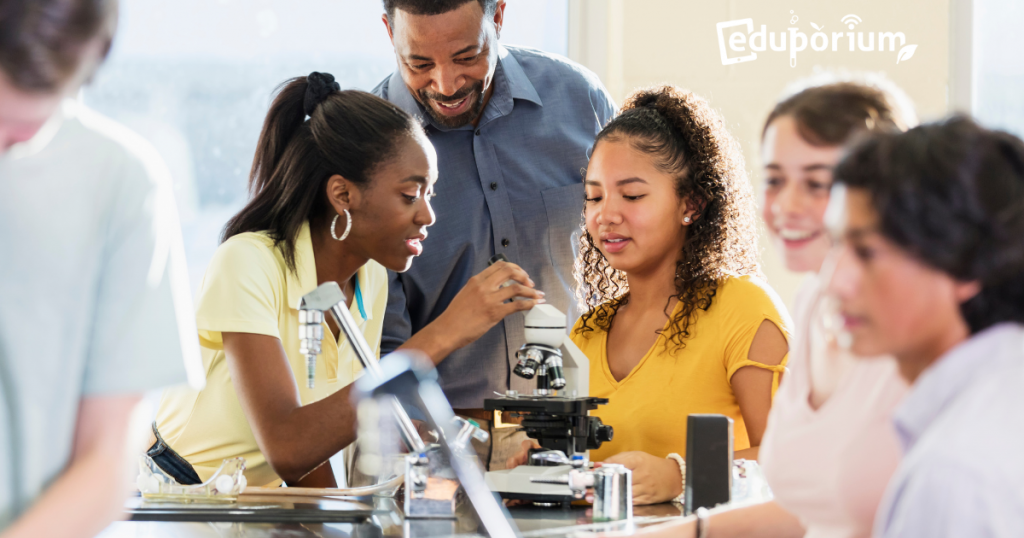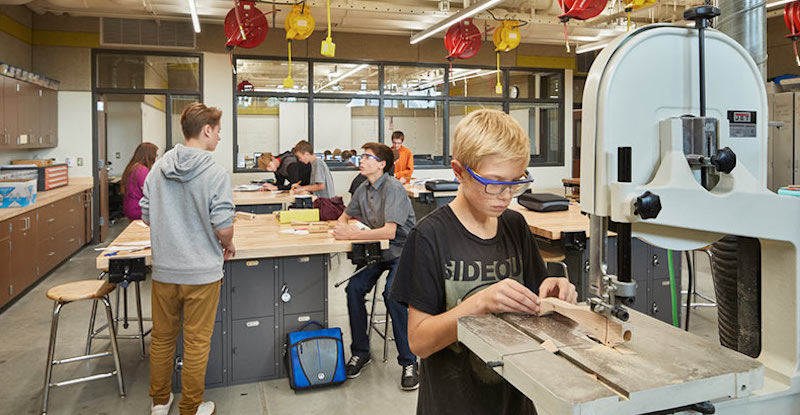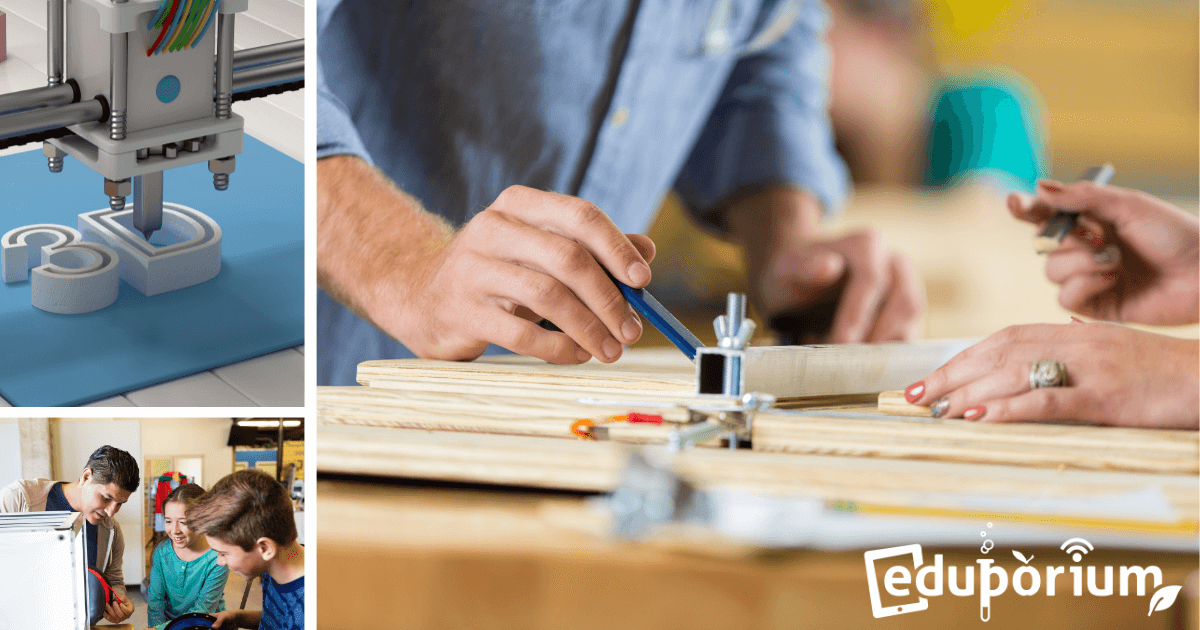We say it all the time that a makerspace can be anything that you want it to be. Seriously, there are no right or wrong ways to build or use the makerspace. They could appear in classrooms, in libraries, in community centers, or in basements, closets, or wherever there is room. The important thing is that students get every opportunity to work with their hands while they're building something meaningful. They don’t even need to use technology. They certainly could if it's available, but low-tech items, like cardboard, tape, and ordinary construction paper are just as valuable. Let’s explore the different kinds of makerspaces and what makes them each of them unique and beneficial for students.
Exciting Examples of Thriving Makerspaces
If you ever come across two makerspaces that are exactly alike, let us know. We’d have to see it to believe it. Every makerspace—whether it’s for students or for adults—is unique from pretty much any other school makerspace. We can pretty much guarantee that. Building a school makerspace is more about what will work for the students using it then it is about what has worked well for other teachers in the past. With that being said, however, just about every makerspace has general traits in common. One of the most common is that they should strive to promote inclusion for people of all ages, genders, and those with different skill levels. Makerspaces shouldn't only be for certain types of people. If someone has a creative appetite and ideas for constructing creative projects, they are welcome.
Another popular trend in makerspaces is the revitalization of the manufacturing industry. Many of the jobs in this part of the workforce have been taken over by machines and those workers who were all displaced have often turned to makerspaces to sort of reinvent the work they had been doing. Here, people who use the makerspace are not just grabbing tools and making anything. They’re constructing things that are very relevant and helpful in their communities. Though, in this case, these are mostly adults, the same principle applies to children in a school makerspace. Makerspace leaders can also apply for grants to help get their programs off the ground or bring in new tools. If researched properly, school and community makerspace leaders can quickly improve their space and help it thrive.
While accessibility and inclusion are great starts to generate interest in makerspaces, there are other ways to keep people coming back. These—unsurprisingly— include keeping technology up to date, encouraging a sense of community, and fostering new ways for children to feel like they're truly making a difference with what they create. In terms of the technology, the more options students have, the better. If possible, adding 3D printers or CNC machines to your school makerspaces is really great! Specifically, when it comes to 3D printers, there are plenty of models that are under $500 to help with cost. Other than that, some of the best things you can have in the makerspace are coding tools, robotics equipment, opportunities for productive failure, and as much collaboration as possible.
Creating a Makerspace In 5 Easy Steps
Makerspaces are everywhere these days, but we focus on leveraging them in educational settings—mostly schools and libraries. From an early age, it’s crucial that educators can help foster curiosity in students and even create authentic learning connections that they can transfer into the real world. The Maker Movement is one example of teachers giving children control of their learning while keeping it real world-relevant. Just look at some of the skills students develop through making: creativity, collaboration, and critical thinking to name a few. Those are all skills that many employers actively seek. There's no wrong way to build a school makerspace as an environment where kids can dream, create, experiment, and grow.
In order to create the best makerspace possible, it requires some planning. The first thing teachers should do, ironically, is their homework. Starting a makerspace doesn’t mean you have to reinvent the wheel, and finding inspiration from other teachers is a great start. Whether that’s in person or on social media, you will find lots of valuable information for getting started. After finding some ideas, it’s time to find some supplies. Especially if teachers don’t have part of the school’s budget allocated for the makerspace, it’s important to maximize every resource. There are tons of materials kids can use in any school makerspace, like popsicle sticks, paint, cotton balls, tape, glue, glitter, and whatever else. The good news is these materials might be lying around somewhere—on a classroom shelf, in a closet, or at a student’s home. Gather everything you can and bring it to the makerspace!
Another thing that’s worth doing is exploring different spaces. If you’re lucky, the school might have a few options for locations, like the library, an art classroom, or another unused room. See what works best for your goals, materials, and plans. After finding a space and getting everything set up, try introducing some regular design challenges. These will help with getting students excited about new opportunities they can participate in and help create some momentum for the new makerspace offerings. Finally, it’s important for makerspace leaders to take some time to establish curricular connections. While much of the making will probably take place after school, it’s still important that students are engaged in relevant work! There you have it—some getting-started ideas for making your school’s makerspace the place to be.

Developing a Maker Mindset Beyond the Makerspace
Some of the skills that students can learn in the makerspace are invaluable. Not only do they help these kids solve problems while they’re in the makerspace, they’re invaluable because they help them learn how to solve problems everywhere—all kinds of problems. It is known as a maker mindset because the ways a student's mind starts turning when they are inventing or problem solving in a makerspace is similar to how they use their problem-solving abilities in all areas of their education and even outside the classroom. Any time a student learns to think like this, they’re on the right track for real-world success. Not all do, however, and some need an invitation or extra bit of motivation. Some just need the opportunity to practice a maker mindset and, if every classroom had this vibe, there would certainly be more students with this mentality.
Especially today, the ability to think creatively is just as important as math, reading, and writing skills. In the makerspace, students often generate ideas at the conceptual level, refine them, and tangibly bring them to life. Authentic, finished products they can hold in their hands and use productively embody what making is all about. Simply by taking some time to construct something useful, they'll become a maker. Makerspace tinkering leads to kids embracing that ever-important maker mindset and thinking outside the box to solve problems and connect seemingly unrelated ideas. This, of course, is the kind of thinking they'll need in the real world. They need to become innovative thinkers. While it seems that many of the skills students learn in a makerspace are categorized as soft skills, there's no way to state just how important they are. These are the skills that will set them up for success.
If every classroom had a makerspace, children would get a chance to develop these skills more frequently. While this might not be fully feasible, educators could bring makerspace elements into everything that they teach. They can start by remembering that all kids are maker and the maker mindset could help on any day in any subject. They should also ensure that all students have access to creative projects not just mundane and repetitive lessons. Third, if teachers can find time—maybe just one or two days a month—to bring their lessons physically into a makerspace so kids can create tangible projects based on what they are covering, then that’s a win. Creating opportunities like this can be tough—we get it. Makerspaces aren’t only about the tools inside them, however. They empower kids to build maker mindsets to take everywhere else. With achieving that, you're on the right path.
Ideas for Creative Makerspace Configurations
One of the biggest reasons makerspaces help teachers to facilitate productive learning is because they are different from traditional classrooms. There aren’t usually desks in the makerspace and it’s fairly rare to find children sitting on chairs. Some of the best makerspaces have different sections where students can focus on different things. Maybe there's a spot for everyone to gather and work on a big project together, a quiet corner where children can take a break and read, tables for small group projects, or plenty of other unique stations. Research has shown that flexible environments like the ones we just described can help promote creativity. Even temperature and light levels can affect how creative kids are when they're in a makerspace.
Makerspaces should also be set up to allow kids to collaborate and participate in discussions. Obviously, there are tons of ways to do this, so we’ll leave that up to educators to decide what is best. As long as the makerspace promotes open-ended and authentic learning and allows your students to investigate different outcomes, that's ideal. They should also be places where kids can take risks and reflect on why something worked or did not. In this kind of environment, they're better able to take their time and think creatively and develop their ideas rather than rushing through projects simply to get it done. Research has actually shown that desk clusters (5-6 seats per cluster and 5-6 clusters) is an ideal environment for facilitating group work in a classroom or, in this case, a makerspace.
Aside from the layout, there are also a few other factors that contribute to successful learning. The color of the walls, for example, can actually play a role in their engagement. Research has shown that red promotes activity and catalyzes passions in students. Removing clutter from walls or other areas and replacing it with personalized student spaces can also reinforce focus and engagement. And, the lighter the room, the more success kids tend to have. Moreover, when using digital tools, eliminating extra words, pictures, and media from materials can provide a more succinct experience and adding visual cues can help prompt kids to get to what they’re doing a bit faster. We know that every makerspace is different and it is definitely up to each individual teacher to decide what works best for them, but, hopefully, some of our tips can be useful in any design for a new makerspace.

Mobile Makerspaces Make an Impact
Our world is incredibly mobile these days. We can watch movies and television on a phone that fits in our pocket. We can create documents, images, and videos on that same phone all while streaming music from anywhere in the world. Mobile technology is huge (obviously) and have led to other things becoming easier, which makes them just as big. Makerspaces are one of those things. You may have heard the term ‘mobile makerspace’ before. This can mean one of two things. It can be a box or a cart of equipment that teachers transport from room to room depending where they're working that day. It could also refer to a car, van, or truck. Maker enthusiasts are now commonly refurbishing old vehicles to transform them into new mobile makerspaces so they can drive them to all different places and inspire making throughout the community!
The only thing better than STEAM learning, programming, and engineering, if you ask us, is taking each on the road to impact even more kids. Mobile makerspaces facilitate access to STEAM learning opportunities for many more kids, especially any who won't often get to participate during the school day. Many parents don’t even realize these kinds of technologies exist and are routinely blown away when they discover their potential. Children and parents can explore new technologies together when mobile makerspaces pop up within their towns or their schools. Since many people are avoiding libraries these days, this is also a way to bring new-and-improved libraries to them!
Especially when it comes to mobile makerspaces, a lot of the learning is very much self-directed. It’s more common for facilitators to simply provide supplies and let kids start inventing and creating whatever they'd like. This routinely spurs creative awakenings as kids explore trial and error and discover what works when inventing. Mobile makerspaces can also show both children and adults that libraries aren't just places filled with old books. They're evolving to support the needs of today’s children by incorporating opportunities for innovation and hands-on technology use. When it comes to taking materials out of the libraries, the mobile makerspace concept can work in any number of ways. You can use any vehicle you want, any technology you want, and create any kind of educational programs you want. The No. 1 rule of makerspaces remains ‘Just have fun and create something!’
For the latest EdTech, STEM, and 21st century education news, follow us on Twitter and Instagram. Like us on Facebook, too, or sign up for our newsletter for our latest product announcements and offerings. If you have an idea for an Eduporium Weekly theme, send us a message on social media or comment below.



